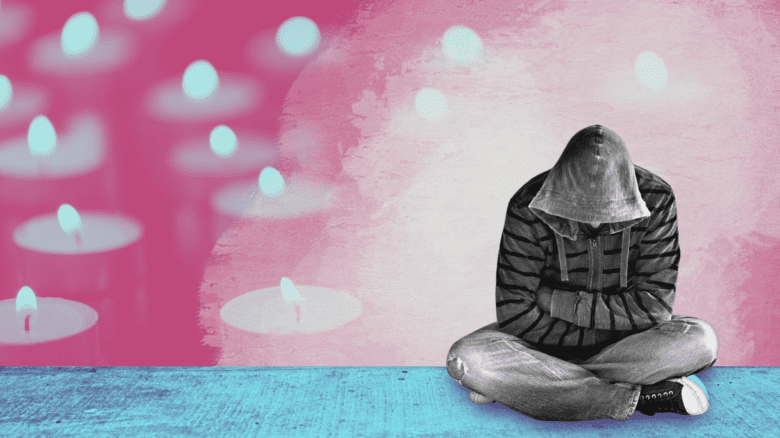At Port-Cartier Institution in northern Quebec, guards twisted Nicholas Dinardo’s arm behind their back with such force that they broke it—an incident even Correctional Service Canada (CSC) recognizes was an excessive and disproportionate use of violence. This is one of the few occasions in which violence against an incarcerated person has been reported publicly.
More common are the unreported stories provided to Xtra by incarcerated people themselves and their legal advocates. Stories like that of Alexa, who was incarcerated in a federal prison over a decade ago and alleges that guards would let other inmates come into her cell to rape her. Or that of Darla, incarcerated in another federal prison, who alleges that she was sexually assaulted in her cell by fellow inmates, some of whom stood watch at the door for passing guards. In order to protect the safety of these and other incarcerated trans, non-binary and Two-Spirit people, Xtra has agreed to grant them pseudonyms and to not publish the names of their institutions or the offences with which they were charged.
The fact is, trans, non-binary and Two-Spirit people held in Canadian federal custody face violence and injustice on a daily basis. The government’s discriminatory policies are only making matters worse.
There were 99 openly trans, non-binary and Two-Spirit people in federal custody when CSC last published data on its gender-diverse inmate population, in 2022. Of those, 62 percent identified as trans women and 21 percent as trans men. The vast majority were housed in institutions that corresponded with their birth sex rather than their gender identity: 67 percent of trans women were housed in men’s institutions, and 95 percent of trans men were housed in women’s institutions.
Amy Matychuk practises prison law in Calgary. She currently represents about five percent of the trans women in federal custody.
Matychuk says that the reason why most trans women are housed in men’s institutions is that CSC keeps finding an “overriding health and safety concern” to keep them there.
The issue is CSC policy.
In June 2017, the Government of Canada amended the Canadian Human Rights Act to explicitly prohibit discrimination on the basis of “gender identity” and “gender expression.” CSC responded later that year by enacting an interim policy for managing gender diversity in federal institutions. That policy was finalized in 2022 as Commissioner’s Directive 100 Gender Diverse Offenders.
The directive specifies that, at intake, “offenders will be placed according to their gender identity or expression in a men’s or a women’s institution, if that is their preference, regardless of their sex (i.e., anatomy) or the gender/sex marker on their identification documents. In the event there are overriding health or safety concerns that cannot be resolved, the offender will be placed in a site that better aligns with their current sex (i.e., anatomy).”
Likewise, during the course of their sentence, people may voluntarily transfer to an institution that better aligns with their gender identity. But this, too, is subject to “health or safety concerns” and approval by either the assistant commissioner for Correctional Operations and Programs (when applying for a transfer to a men’s institution) or the deputy commissioner for Women (when applying for a transfer to a women’s institution).
“In my experience,” Matychuk says, “these transfer requests are frequently denied … and almost every application to transfer from a men’s to a women’s prison that I’ve seen has been denied on the grounds of health and safety concerns.”
The deciding factor, Matychuk has found, is a person’s genitalia.
Megan has been in federal custody for more than 25 years.
She’s known she was a woman since she was 10. But when she was incarcerated at 21 years old, she knew prison was “not a safe space” in which to come out and disclose her gender identity.
Other trans women in the men’s system suffered “the most horrible abuse not only from their fellow inmates, but also from staff,” Megan tells Xtra, and that “entrenched me into my closet even more.”
It was only after she began to process her own trauma—including the trauma of going through male puberty—that Megan began to come out of that closet.
In 2018, she came out to her case-management team as “gender neutral” and was met with significant confusion. “Most staff didn’t know what the hell to do with me,” she says. There were questions about why she was only coming out now, and how this news related to risk management, she says.
A few months later, Megan officially started identifying as a woman, adopted she/her pronouns and came out to others housed in the men’s institution she was in.
“Almost from day one,” she says, “I had to start filing complaints to get my basic gender needs met.”
Staff made no effort to use her pronouns or to respect her search protocols. “If you want special privileges in a prison, [transitioning] is not the way to go about it,” she reflects.
In 2019, a male correctional officer allegedly sexually assaulted her during a search. CSC considered it merely a policy violation.
Megan applied to be transferred to a women’s institution on three different occasions and was denied each time despite being a minimum-security inmate with no institutional charges.
In 2022, after fighting CSC for access for over a year, she received breast augmentation. Her augmented breasts triggered a lot of unwanted attention and harassment from fellow inmates. Two of them cornered and sexually assaulted her. Megan had to physically fight her way out. One of the alleged perpetrators later confessed to the assault; CSC kept him in Megan’s unit.
Megan was scheduled to receive gender-confirming vaginoplasty later that year at GrS Montreal. Three days before her surgery was scheduled to take place, she received a phone call from her parole officer. The deputy commissioner for Women still hadn’t decided whether to allow Megan into a women’s institution post-vaginoplasty. She had to decide for herself whether to go through with the surgery and risk going to a men’s institution afterward, or to postpone it and live with the mental health challenges of ongoing dysphoria.
“I don’t know if you can even fathom how terrifying that was for me,” she says. Were her transfer request to be denied again, “the threat of rape would have been constant.”
She decided to go forward with her surgery anyway. Thirty minutes before it was scheduled to take place, she found out she would be transferred to a women’s institution afterward.
It was a “gigantic relief,” she says.
Prisoners’ Legal Services (PLS) is a clinic in British Columbia that provides legal aid to people incarcerated in that province.
They tell Xtra that “out of 47 requests by gender-diverse individuals for placement or transfer to institutions designated for women … only seven (or 15 percent) were approved, while 34 (or 72 percent) were denied (another six were either withdrawn or pending).”
Nicole Kief is a policy director and senior legal advocate at PLS. In her experience, transphobia saturates CSC’s approach to managing the trans, non-binary and Two-Spirit people in its custody.
Dinardo is a PLS client who identifies as a Two-Spirit transfeminine person. Since coming out, Kief says, “they’ve spent most of their time in ‘structured intervention units,’ which are … basically like another form of isolation.” CSC, she says, “has refused to transfer them to an institution designated for women and relied on transphobic stereotypes in making those decisions.”
Those sorts of stereotypes saw the light of day in Boulachanis v. Canada (Attorney General), a 2019 Federal Court decision that granted Jamie Boulachanis a transfer to a women’s institution. In opposing Boulachanis’s transfer application, the federal government relied heavily on the transphobic myth that “the escape risk of a person with male anatomy, even though she identifies as a woman and is transitioning to become a woman, can be different simply by virtue of her physical capabilities and muscular strength associated with her male chromosomes.”
The court rejected that argument, and the biological determinism on which it rests, as “discriminatory prejudice.” But it’s an argument that continues to underlie CSC policy and decision-making.
CSC refuses to change a person’s sex designation in their electronic Offender Management System unless that person undergoes gender-confirming bottom surgery; which means that a pre-operative trans person’s sex assigned at birth appears in the header of every official document relating to them, effectively outing them to decision-makers and exposing them to discrimination. Transfeminine people in men’s institutions are put in men’s programming, Kief explains, and CSC then uses the fact that they haven’t done appropriate programming to deny their transfer to a women’s institution. And CSC routinely uses factors like a trans person’s “high mental health needs” to deny them a transfer.
All of this is despite the fact that CSC would never house a cis woman in a men’s institution for these same reasons, no matter the health, safety or programming concerns.
Of course, even when trans women are transferred to women’s institutions, Kief says, there’s this idea floating around that “prisons designated for women are these super trauma-informed, healing, restorative, supportive utopias, which is definitely not what they are.” Kief puts it bluntly: maximum security is overused, Indigenous women are over-securitized, guards use force and perform routine strip searches and other indignities occur that make women’s institutions punitive, dehumanizing and degrading places in which to exist.
But the alternative is often much worse.
Aurora was already on feminizing hormone therapy when she was first incarcerated. CSC took her off it and placed her in a men’s institution. It was 18 months before CSC allowed Aurora to continue her medical transition.
In her five years of incarceration, Aurora was housed in six different institutions, because guards would disclose her gender identity and the charge for which she was imprisoned to other incarcerated people “and that would cause issues, and people would want to stab me up, rape me, beat me—take your pick.” Kief explains that guards routinely discuss intimate details relating to a person’s gender identity where other incarcerated people can hear them, exposing trans people experiencing imprisonment to sexual, physical and psychological violence from incarcerated people and staff.
“I went through a lot of rapes in the bathrooms,” Aurora says, “because there’s no cameras in the bathrooms.” She felt like “a piece of meat [thrown] to wolves.”
It’s true that of the openly trans people in federal custody, most are serving lengthy prison sentences. But this is not because trans people are more likely than their cis peers to commit serious criminal offences. Rather, Matychuk explains, it is more likely the case that trans people serving shorter sentences for relatively minor offences simply decline to disclose their true gender identity in order to protect themselves.
“The only people who feel the need to be trans and out in custody,” Matychuk says, “are the people who are there for a very long time.”
Indeed, as an openly trans or non-binary person in federal custody, all transitioning does is increase the likelihood that you will become the victim of a violent crime behind bars.
Xtra asked CSC whether it is satisfied with the implementation of Commissioner’s Directive 100. CSC replied that it is “currently undertaking a compliance review … which will assist in identifying areas for future amendments to the existing policy framework concerning gender diverse offenders.”
The people Xtra spoke to say that several things need to change to make federal institutions a safer and more humane place for incarcerated trans people.
Decisions about transition-related care need to be taken out of CSC’s hands, Aurora says. “It has to be through a program outside of their reach and their control, in the community where they can’t stop the progress from moving forward.”
Correctional officers should be required to undergo ongoing training related to gender identity and diversity, Megan says.
And the “overriding health and safety concerns” clause needs to be dropped from CSC policy, Matychuk insists. It’s a cover for systemic transphobic discrimination, and allows CSC to treat trans women as men and trans men as women, when neither is the case.
Matychuk hopes to bring a constitutional challenge to Commissioner’s Directive 100, alleging discrimination on the basis of sex contrary to Section 15 of the Canadian Charter of Rights and Freedoms. For that to occur, she needs incarcerated people to come forward and fight for their rights in court.
Incarcerated trans people have plenty of reasons not to do so: the very real risk of reprisal chief among them. But it’s a fight worth having, and all incarcerated trans people stand to benefit.
Too many folks think incarcerated trans people deserve the violence and discrimination they receive in prison, Megan reflects. At best, she says, as “inmates, we quite often feel we’re invisible behind these fences. [But] I’m more than just my file.”


 Why you can trust Xtra
Why you can trust Xtra


